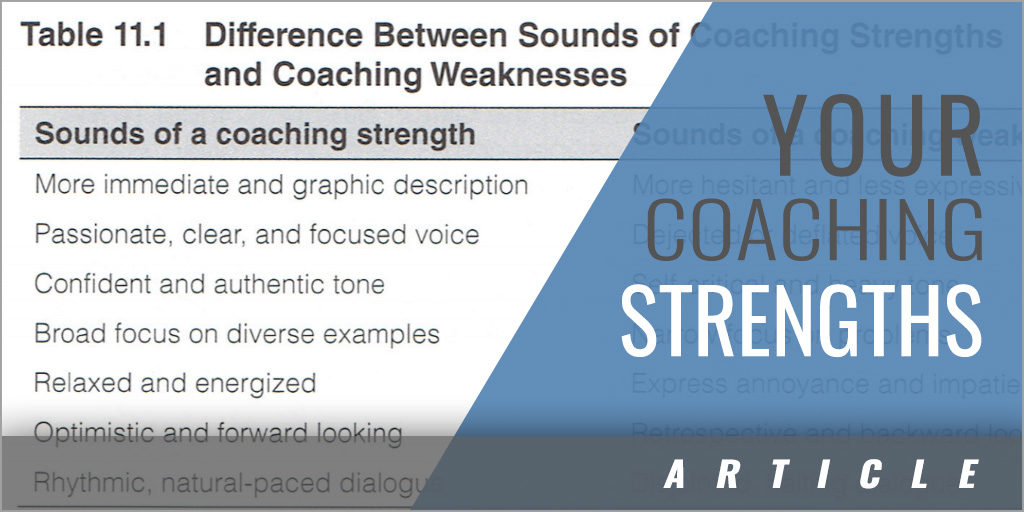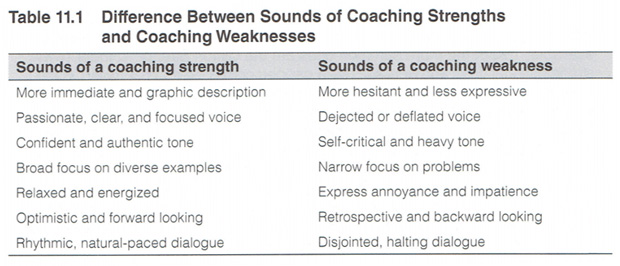|
By: Wade Gilbert Originally Published in: Coaching Better Every Season Provided by: Human Kinetics The traditional approach to coaching is sometimes referred to as a deficits-based approach because coaches focus their energy on identifying and fixing weaknesses, or deficits, in their athletes, programs, and coaching practices." Although coaches should certainly work toward closing performance gaps (the focus of chapter 12 of this book), the most successful people focus more on knowing and growing the things they are good at, referred to as a strengths-based approach to coaching. World and Olympic championship soccer coach Tony DiCicco knew the value of this approach and advised coaches to "Know your limitations, but coach to your strengths." Coaching strengths are those instinctive coaching characteristics - such as behaviors, feelings, or ways of thinking - that are authentic and energize optimal performance. Coaching strengths are authentic because coaches feel like the "real me" when they are using their strengths. By focusing on their strengths, coaches act in ways that are aligned with their purpose and core values; they are acting with authenticity. When people use their strengths, they are more engaged with their work and report a surge in energy and performance, greater happiness, and more optimism. The strengths-based approach is founded on five core principles:
Five-time national championship and all-time winningest American college baseball coach Augie Garrido is another example of a coach who has built a successful career around the principles of strength-based coaching. He advises coaches to build around their natural strengths: "Why not focus on strengths instead of weaknesses? My contention is that we should use the best weapons available to us. Build momentum by building on whatever comes naturally to you." Although knowing and growing coaching strengths has many benefits, including counterbalancing the inherent tendency to focus on the negative, the most effective coaches develop a keen awareness of how and when they can best use their strengths. If coaches understate or minimize their strengths, they will miss prime opportunities to maximize performance. On the other hand, if coaches overstate or blindly emphasize their strengths regardless of the situation, they risk missing opportunities for identifying and growing other strengths. Coaches should always use their strengths but in varying degrees depending on the particular situation, much as we adjust the volume control on our electronic devices. For example, a coach may determine that one of her strengths is listening to others. She should always use this strength, but the situation will dictate whether she needs to dial-up her listening (listen more before acting) or dial down her listening (listen less and move quickly to action). This ability to control the use of strengths is a defining characteristic of wise strengths application. The process of identifying strengths is commonly referred to as strengths spotting. Although perhaps not self-evident when starting a coaching career, the best coaches learn over time what aspects of coaching suit them best. Successful coaches like legendary American college basketball coaches Pat Summitt and John Wooden were keenly aware of their strengths. For Coach Summitt it was teaching and building young people: "If I were not coaching I'd be in a classroom. I'd be somewhere spending my time with young people. They give me energy. I just love it. It's in my system." For Coach Wooden it was observation and analysis skills: "I have always considered myself average in many areas. However, my strength is in analyzing players and statistics. I loved digging deep into information to see what I could find. Unfortunately, coaches often go many years, sometimes decades, into a coaching career before they become fully aware of their strengths. Many strengths-spotting tools are available, but typically these have a fee and none of them appears to be created specifically for sport coaches. The following section contains suggestions for accessing and in some cases adapting some common tools for spotting strengths. These tools will help coaches and those who work with coaches, such as athletics directors and coach educators, to identify and build on coaching strengths. Dr. Alex Linley describes three strengths-spotting strategies that can easily be adapted for sport coaching: (a) day-to-day strengths spotting, (b) listening for strengths, and (c) strengths-based interviewing. Day-to-day strengths spotting requires coaches either to have someone else observe them or to observe themselves on videotape in their regularly coaching activities such as during a practice, competition, or meetings. The goal of this strengths-spotting exercise is simply to watch the coach in action and be open to noticing moments of strength. Moments of strength are revealed when coaches display one or more of the telltale signs of a coaching strength:
The key to the day-to-day strengths-spotting exercise is to look for repeated moments that demonstrate patterns that indicate a coaching strength. Athletes should definitely be considered prime candidates for serving as strength spotters because they are the ones who have the most direct view of the coach in action across various situations. For example, coaches might consider asking their athletes to complete anonymous strengths-spotting cards at the end of the season. Athletes could be asked to complete the following prompt: You were at your best as a coach this season when you..." Clear patterns will emerge across athlete responses to reveal coaching strengths that should be used often. Strengths can also be revealed by listening carefully to the way that coaches speak about their work. People sound noticeably different when they are asked to speak about a weakness compared with talking about a strength. A list of the differences between the sounds of weaknesses and strengths that has been adapted for sport coaches is presented in table 11.1.
Listening for strengths can be accomplished by asking coaches to describe typical coaching situations. The responses should be audio taped so that the coach, or coach mentor, can listen for the sounds listed in table 11.1 to learn whether the coach was displaying a strength in handling the coaching situation. For example, coaches may set aside a few minutes after practices and competitions to record themselves speaking freely about two or three situations that occurred that day (e.g., interactions with athletes or officials, planning decisions, or strategy adjustments). This exercise will help coaches increase their self-awareness of coaching strengths and the types of situations in which they can use those strengths more effectively. A third strengths-spotting strategy for coaches is strengths-based interviewing. With this strategy, coaches write responses to three items:
The coach, or a coach mentor, then looks across the written responses for patterns that reveal coaching strengths. For example, my responses to these three questions based on a recent season of coaching youth soccer follow. This example can be used as a practice activity for identifying a coach's strengths. What strengths can you identify in these responses?
|







